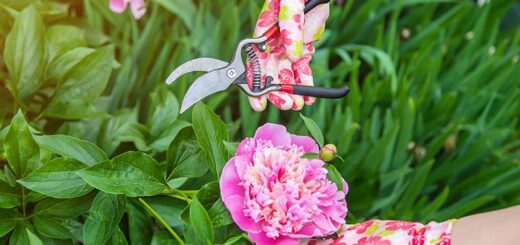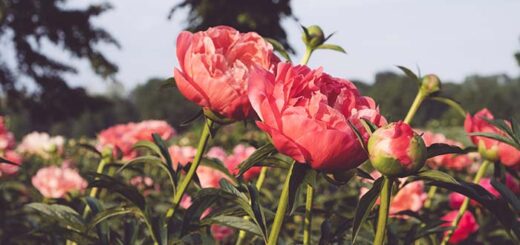Peony Growing Conditions
Peonies are beloved for their lush, fragrant blooms and ability to thrive in various climates. Whether you’re a novice gardener or an experienced horticulturist, understanding the optimal growing conditions for peonies is vital to cultivating these stunning flowers successfully. This article explores everything you need to know about peony growing conditions, from soil and sunlight requirements to watering and seasonal care. Let’s dive in!
Introduction: What Are the Ideal Peony Growing Conditions?
Peonies are perennial plants that can live for many decades, often outlasting the gardeners who plant them. To ensure they flourish year after year, peonies need specific growing conditions. The ideal environment for peonies includes well-draining soil, ample sunlight, and careful attention to watering and seasonal maintenance. By providing these conditions, you can enjoy the beauty and fragrance of peonies in your garden for many years.
Soil Requirements for Peonies
Well-Draining Soil
Peonies prefer well-draining soil to prevent root rot and other moisture-related issues. Heavy, clay-based soils that retain water can be detrimental to peonies. You can amend the soil with organic matter such as compost or well-rotted manure to improve drainage. Raised beds can also be a good option if your garden soil is particularly heavy.
Soil pH and Fertility
Peonies thrive in slightly acidic to neutral soil with a pH range of 6.0 to 7.0. Conduct a soil test to determine the pH level of your garden soil and amend it if necessary. Adding lime can help raise the pH if the soil is too acidic, while sulfur can lower it if it is too alkaline. Additionally, incorporating a balanced, slow-release fertilizer during planting can provide the nutrients peonies need to establish and grow.

Image Source: Envato Elements
Sunlight Requirements
Peonies require a good amount of sunlight to produce abundant blooms. Ideally, they should receive at least 6 to 8 hours of direct sunlight daily. In hotter climates, providing afternoon shade can help protect the plants from scorching. Planting peonies in a location with adequate sunlight ensures robust growth and vibrant flowers.
Watering Peonies
Consistent Moisture
Peonies need consistent moisture, especially during the growing season. However, overwatering can lead to root rot, so striking a balance is essential. Water peonies deeply, allowing the soil to dry slightly between watering sessions. Mulching around the base of the plants can help retain soil moisture and reduce the watering frequency.
Watering Techniques
Watering peonies at the base of the plant, rather than from above, helps prevent fungal diseases that can develop on the leaves and flowers. A soaker hose or drip irrigation system delivers water directly to the root zone, keeping the foliage dry and reducing disease risk.
Seasonal Care for Peonies
Planting Peonies
The best time to plant peonies is in the fall, typically between September and October. This allows the plants to establish their root systems before winter. When planting, dig a hole large enough to accommodate the roots and position the eyes (buds) of the peony root no more than 2 inches below the soil surface. Planting too deep can result in poor flowering.
Mulching and Winter Protection
Applying a layer of mulch around the base of peonies in the fall helps insulate the roots and protect them from harsh winter temperatures. Use organic mulch such as straw, shredded leaves, or pine needles. In colder climates, additional protection with a layer of evergreen boughs or burlap may be necessary to shield the plants from extreme cold and wind.
Pruning and Deadheading
Deadheading Flowers
Deadheading, or removing spent flowers, encourages peonies to produce more blooms and prevents the plant from wasting energy on seed production. After the flowers fade, use clean, sharp scissors or pruners to cut the flower stems just above the first set of healthy leaves.
Pruning Foliage
In the fall, after the first frost, prune the foliage back to ground level. This helps prevent the spread of diseases and prepares the plant for winter dormancy. Please dispose of the pruned foliage in the trash rather than composting it, as peonies can harbor fungal spores that may persist in the soil.
Common Problems and Solutions
Pests and Diseases
While peonies are relatively hardy, they can be susceptible to pests and diseases. Common issues include:
- Botrytis Blight: A fungal disease that causes buds to rot and stems to wilt. Improve air circulation around the plants and avoid overhead watering to reduce the risk of infection.
- Powdery Mildew: A fungal disease that appears as a white, powdery coating on the leaves. Remove affected foliage and treat with a fungicide if necessary.
- Aphids: Small, sap-sucking insects that can be controlled with insecticidal soap or by encouraging natural predators such as ladybugs.
Nutrient Deficiencies
If the soil lacks essential nutrients, peonies may exhibit signs of nutrient deficiencies. Yellowing leaves, stunted growth, and poor flowering can indicate a need for fertilization. Apply a balanced, slow-release spring fertilizer to provide the nutrients for healthy growth.
Peony Varieties and Their Specific Needs
Herbaceous Peonies
Herbaceous peonies are the most common type and die back to the ground each winter. They require the same basic growing conditions as described above. Popular varieties include ‘Sarah Bernhardt,’ ‘Karl Rosenfield,’ and ‘Bowl of Beauty.’
Tree Peonies
Tree peonies are woody shrubs that retain their structure above ground year-round. Compared to herbaceous peonies, they prefer slightly more shaded conditions and should be planted with their graft union (if present) just below the soil surface. Varieties like ‘Kamata Nishiki’ and ‘Taiyo’ are known for their large, striking blooms.
Intersectional (Itoh) Peonies
Intersectional peonies, also known as Itoh peonies, are hybrids between herbaceous and tree peonies. They combine the best traits of both types, including large blooms and sturdy stems. Intersectional peonies require similar growing conditions to herbaceous peonies and can tolerate a bit more shade. Varieties like ‘Bartzella’ and ‘Cora Louise’ are popular choices.
Conclusion: Cultivating Peonies for Lasting Beauty
Growing peonies can be a rewarding experience. They offer stunning blooms that enhance the beauty of any garden. By understanding and providing the ideal growing conditions—well-draining soil, ample sunlight, consistent moisture, and proper seasonal care—you can enjoy these magnificent flowers for many years. With a little attention and effort, your peonies will thrive, adding color and fragrance to your outdoor space season after season.
FAQs on Peony Growing Conditions
Q: What type of soil is best for growing peonies?
A: Peonies thrive in well-drained, fertile soil with a slightly acidic to neutral pH level (6.5-7.5). Adding organic matter can improve soil quality.
Q: How much sunlight do peonies need?
A: Peonies require at least 6 hours of direct sunlight daily. While they can tolerate partial shade, full sun promotes optimal growth and blooming.
Q: Can peonies grow in containers?
A: Yes, peonies can grow in containers, provided the pot is large enough (at least 18 inches deep) and has good drainage. Use high-quality potting soil and ensure adequate sunlight and watering.
Q: When is the best time to plant peonies?
A: The best time to plant peonies is in the fall, typically between September and November, when the soil is warm enough for root establishment before winter.
Q: How deep should peony tubers be planted?
A: Peony tubers should be planted with the eyes (buds) 1-2 inches below the soil surface. Planting too deeply can hinder blooming.
Q: How often should I water my peonies?
A: Water peonies deeply once a week, especially during dry spells. Mulching helps retain moisture. Avoid over-watering, as peonies dislike soggy soil.
Q: Do peonies need to be staked?
A: Tall varieties and those with large blooms may benefit from staking or using peony rings to support the stems and prevent them from bending or breaking.
Q: What is the ideal climate for growing peonies?
A: Peonies thrive in temperate climates and are hardy in USDA zones 3-8. They prefer cool winters and warm summers with adequate moisture.
Q: How can I prevent diseases in my peonies?
A: Ensure proper spacing for good air circulation, water at the base to keep foliage dry, and promptly remove any diseased plant material. Mulching can also help prevent soil-borne diseases.
Q: When should I prune my peonies?
A: Prune herbaceous peonies to the ground in late fall after the foliage has died. For tree peonies, remove dead or damaged wood in early spring.
Q: How do I fertilize my peonies?
A: Apply a balanced fertilizer in early spring as new growth emerges. Avoid high-nitrogen fertilizers, which can promote excessive foliage growth over blooms.
Q: Can peonies be divided? If so, when?
A: Yes, herbaceous and intersectional peonies can be divided. The best time to divide peonies is when the plants are dormant in the fall.
Q: How long do peony plants live?
A: With proper care, peony plants can live for many decades, often 50 years or more, becoming more robust and productive.
Q: What companion plants work well with peonies?
A: Peonies pair well with plants like irises, daylilies, and hostas, which have similar growing requirements and complement the peony’s blooming season.


